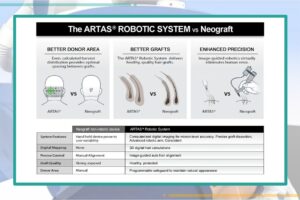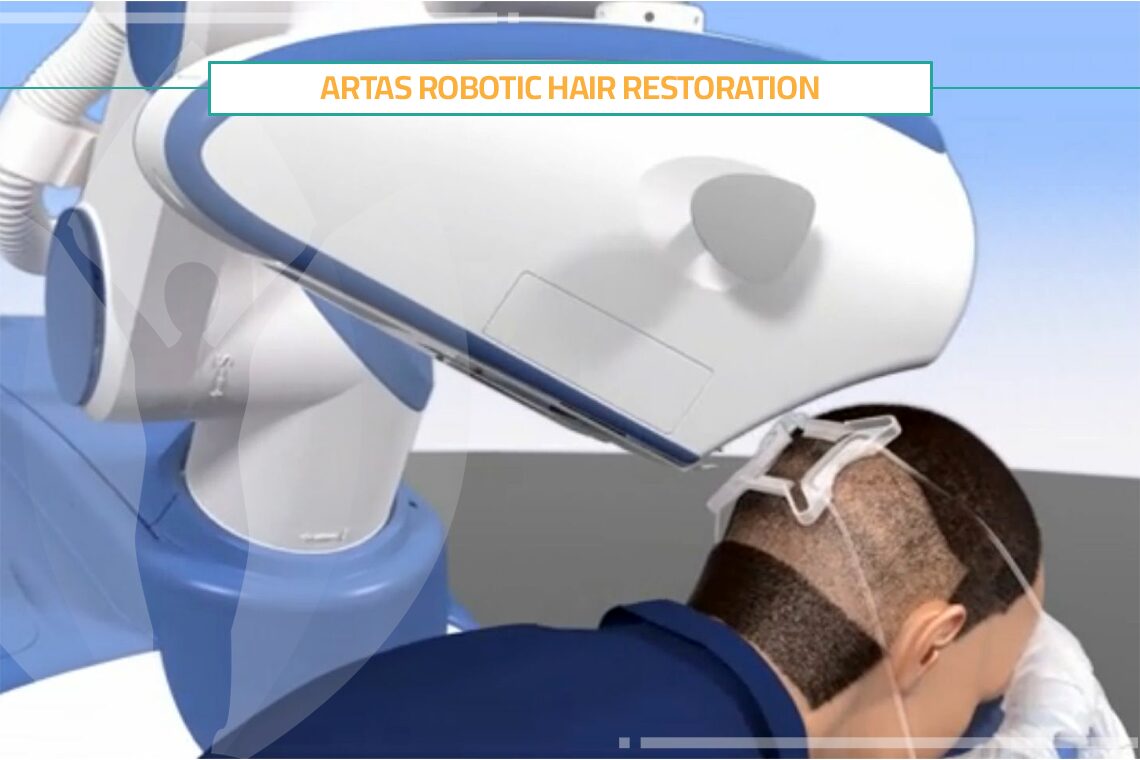ARTAS Robotic Hair Restoration
A cutting-edge robotic artificial intelligence hair restoration tool is called ARTAS Robotic Hair Restoration. Robots are capable of precise, reliable, and consistent execution of delicate, difficult tasks like extracting one hair follicle at a time. A robot eliminates factors like a doctor’s precision, stability, and focus. This is how hair restoration will go forward.
This cutting-edge robot harvests hair follicles without leaving scars by using 3D image scanning. In order to provide a natural appearance, the robotic arm can quickly and precisely put hair follicles in the hairline, temples, and crown. This is a scarless and painless technique.
The hair follicles that ARTAS iX realigns will stay in place for the rest of your life and are not prone to male pattern baldness. For long-lasting effects, most patients just need one therapy session.
ARTAS Hair Transplant
Both manual FUE hair transplants and robotic ARTAS hair transplants with the help of an optical guidance system and a robot arm can treat male and female hair loss.
However, when it comes to accuracy, a seamless hair transplant procedure, and outcomes that look natural, the FUE hair transplant method usually outperforms the robotic alternative.
It is a good idea to understand why FUE hair transplants are more successful if you are thinking about getting a hair transplant in Turkey.
FUE and DHI are two examples of manual hair transplant techniques that have various distinct advantages over robotic ones as follows:
Precision and Artistry: Manual transplants provide the surgeon exact control over the angle, depth, and positioning of each hair follicle, resulting in a more artistic and natural-looking outcome that complements the patient’s natural hair growth pattern.
Adaptability: Trained surgeons are able to modify their methods according to the unique requirements of each patient, offering a customized approach that may not be possible with robotic operations.
Selective Harvesting: When using manual procedures, donor hair is frequently harvested selectively in order to maximize the utilization of scarce donor hair while minimizing damage to already-existing hair follicles.
Surgical Expertise: Unlike automated robotic treatments, manual transplant surgeons rely on their expertise, skill, and tactile input during the process, which allows for real-time changes and a better level of precision.
Robotic FUE Hair Transplant
Our highly qualified and experienced hair surgeons at Natural Beauty use the state-of-the-art Sapphire hair transplant surgical blade during FUE transplant, which enables more accurate and natural placement of individual hair follicles (e.g., hair grafts). With the ability to harvest donor hair follicles from various parts of the body or scalp, sapphire FUE is a great hair restoration technique for those with a limited supply of donor hair.
The FUE Sapphire Technique is one type of manual hair transplantation that has advantages over robotic hair transplantation. For example, sapphire tip blades are stronger, smoother, and sharper than standard steel blades since they are created from a unique gemstone.
These blades produce more delicate and smaller incisions when utilized in manual hair transplant surgery. When it comes to hair harvesting and transplantation, there is more surgical control when using the manual Sapphire FUE procedure.
How Painful Is the ARTAS Hair Transplant?
The ARTAS hair transplant involves locally aestheticizing the scalp till complete numbness. In the event that pain persists throughout the surgery, a doctor will determine whether more anesthesia has to be given to minimize discomfort. Most of the time, the patient is pain-free. Following the treatment, some patients may have mild soreness and edema, which go away in one to three days.
How Is Arms Liposuction Performed?
When Can I Expect to Receive Results?
Hair transplants develop in phases naturally. About three months after the treatment, new hairs start to grow, and they will keep growing for a whole year. You’ll notice a notable difference after around six months, and full benefits will appear after a full year. Individual outcomes and schedules, however, might differ for every patient.

What Benefits Does Robotic Hair Transplantation Offer?
- The robotic grafting system uses algorithms to analyze the density, growth angle, and kind of hair to pick patients whose hair is most suitable for automated extraction. The surgeon’s work is facilitated by this identification.
- Robotic extraction speeds up the procedure by roughly fifty percent and lessens the weariness of the medical staff. Allowing them to concentrate more on implanting the grafts that the robot has extracted.
- Compared to a manual hair transplant, patient comfort is guaranteed with a quicker operation and less sitting time.
- Robotic extraction can lower the cost of a hair transplant by roughly 30% with less manual intervention. Making the procedure more accessible to more patients.
- Ten days following the procedure, there are no visible scars or signs of surgery thanks to non-invasive. Painless automated extraction that is more accurate and less traumatic to the capillary dermis. The next day, the patient can resume their regular activities, given that they heed the surgeon’s instructions for post-operative care.
- Reduced waiting time between graft extraction from donor area and recipient zone implantation increases the likelihood of regrowth, up to approximately 97%.
How Long Will the Hair Last?
The ARTAS hair transplant uses your own permanent growing hair, usually from the back of your head. Your doctor implants this hair to the thinning portions of your scalp. But hair loss may not necessarily halt after transplantation. Transplanted hair usually lasts a lifetime since it may not be vulnerable to the circumstances that induce male pattern baldness. Your physician can evaluate the available treatments for you and go over what to anticipate.
Follow this guide for Full Dental Implants
Getting Ready for Robotic Hair Transplant
You might be wondering where to begin if you’re thinking about getting hair transplants with the ARTAS robotic system. Finding a qualified office that provides this cutting-edge technology is always the first step.
Process of Consultation and Assessment
Your surgeon will assist you in determining whether you are a good candidate for ARTAS during your consultation. Your hairline will be evaluated at this visit. You’ll also review your medical history. For most people who are worried about male pattern baldness, ARTAS is the best option. However, a hair transplant may not be suitable for someone who has chronic health conditions such as diabetes, renal illness, liver failure, heart disease, or kidney failure. Moreover, ARTAS does not have an age restriction. When they reach the ages of 20, 30, and beyond. Many patients become aware of balding patterns and seek out this therapy.
Instructions and Considerations for the Pre-Procedure
The procedures for getting ready for ARTAS are quite easy to follow. Your surgeon will need a list of all the drugs, vitamins, and supplements you are currently taking during your appointment. If anything on your list could complicate surgery, your primary care physician could suggest that you figure out a safe method to stop taking it.
You don’t have to shave your head before ARTAS, although it’s recommended to give it a quick cut. During your appointment, you will receive guidance on the ideal kind of transition cut. In general, on the day of the treatment, hair should be trimmed to a minimum of 1 millimeter.
It is recommended that you spend as little time in the sun as possible in the weeks before your treatment. Steer clear of any activities that could cause sunburn. It’s also advised to spend the 48 hours preceding this treatment essentially indoors. Sunscreen and protective clothes are a necessary if you must be outside! Maintaining proper hydration in the days before your checkup is also crucial.
Controlling Expectations and Assigning Reasonable Objectives
Similar to all hair transplants, the specific type of hair loss experienced by each patient greatly influences the outcome. Because of this, it’s critical to set reasonable expectations for what may be accomplished given the particulars of your case. The effectiveness and precision of ARTAS can significantly raise the chances of a robust, successful transplant. Even if no surgeon can guarantee a 100% restoration after a hair transplant treatment.
Robotic Hair Transplant Cost
In Turkey, the cost of an ARTAS robotic hair transplant ranges from $544 to $3810, with an average cost of $2177.





